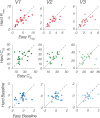Heterogeneous Effects of Cognitive Arousal on the Contrast Response in Human Visual Cortex
- PMID: 40280712
- PMCID: PMC12178281
- DOI: 10.1523/JNEUROSCI.0798-24.2025
Heterogeneous Effects of Cognitive Arousal on the Contrast Response in Human Visual Cortex
Abstract
While animal studies have found that arousal states modulate visual responses, direct evidence for effects of arousal on human vision remains limited. Here, we used fMRI to examine effects of cognitive arousal on the gain of contrast response functions (CRFs) in human visual cortex. To measure CRFs, we measured BOLD responses in early visual cortex (V1-V3) while participants (n = 20, 14 females and 6 males) viewed stimuli that parametrically varied in contrast. To induce different cognitive arousal states, participants solved auditory arithmetic problems categorized as either Easy (low arousal) or Hard (high arousal). We found diversity in the modulatory effects across individuals: some individuals exhibited enhanced neural response with increased arousal, whereas others exhibited the opposite effect-a decrease in response with increased arousal. The pattern of overall BOLD modulation showed within-individual stability and was correlated with the degree of arousal-driven change in pupil size. Individuals who exhibited larger increases in pupil size with the arousal manipulation tended to show greater arousal-related decreases in visuocortical responses. We speculate that the polarity of the modulatory effect by cognitive arousal may relate to individual differences in cognitive effort expended in the high-difficulty condition, with individuals reaching different points on an underlying non-monotonic function.
Keywords: BOLD; arousal; contrast response functions; fMRI; vision.
Copyright © 2025 Pan et al.
Conflict of interest statement
The authors declare no competing financial interests.
Figures









Similar articles
-
How does orientation-tuned normalization spread across the visual field?J Neurophysiol. 2025 Feb 1;133(2):539-546. doi: 10.1152/jn.00224.2024. Epub 2025 Jan 7. J Neurophysiol. 2025. PMID: 39772970 Free PMC article.
-
Pupil-Linked Arousal Modulates Precision of Stimulus Representation in Cortex.J Neurosci. 2024 Oct 16;44(42):e1522232024. doi: 10.1523/JNEUROSCI.1522-23.2024. J Neurosci. 2024. PMID: 39151956 Free PMC article.
-
Trying Harder: How Cognitive Effort Sculpts Neural Representations during Working Memory.J Neurosci. 2024 Jul 10;44(28):e0060242024. doi: 10.1523/JNEUROSCI.0060-24.2024. J Neurosci. 2024. PMID: 38769009 Free PMC article.
-
Pharmacological and electronic cigarette interventions for smoking cessation in adults: component network meta-analyses.Cochrane Database Syst Rev. 2023 Sep 12;9(9):CD015226. doi: 10.1002/14651858.CD015226.pub2. Cochrane Database Syst Rev. 2023. PMID: 37696529 Free PMC article.
-
Prenatal administration of progestogens for preventing spontaneous preterm birth in women with a multiple pregnancy.Cochrane Database Syst Rev. 2019 Nov 20;2019(11):CD012024. doi: 10.1002/14651858.CD012024.pub3. Cochrane Database Syst Rev. 2019. PMID: 31745984 Free PMC article.
References
MeSH terms
Substances
Grants and funding
LinkOut - more resources
Full Text Sources
